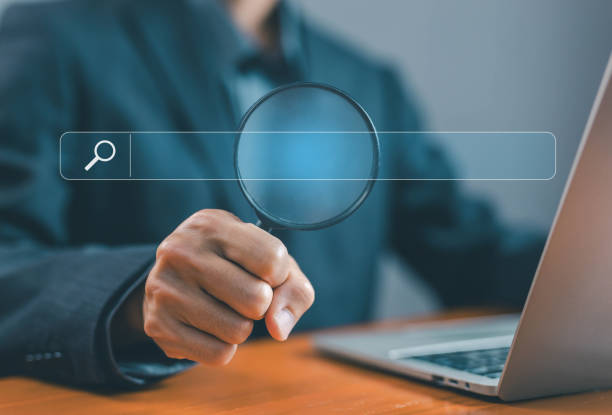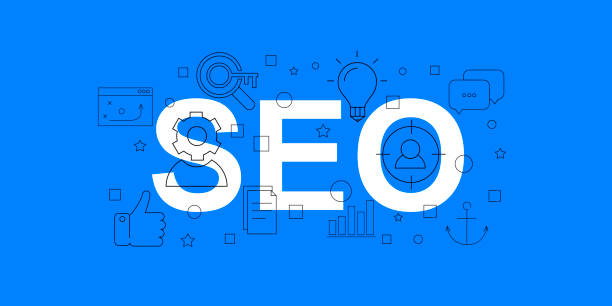Introduction to SEO and its Importance in the Digital World

In today’s highly competitive world, an online presence is not achieved merely by having a beautiful website; it requires visibility and accessibility by target audiences.
This is where #SEO, or Search Engine Optimization, plays its crucial role.
SEO is a set of techniques and strategies aimed at improving a website’s ranking in the organic results of search engines like Google, Bing, and Yahoo.
Imagine you have a physical store; without a sign, an attractive display, and a suitable location, how can customers find you? Your website is the same in the virtual space.
Without paying attention to search engine #algorithms and Search Engine Optimization strategies, your valuable content will get lost in the vast amount of information available on the internet.
The importance of SEO goes beyond merely increasing traffic; it means attracting targeted traffic.
That is, users who are precisely looking for the products, services, or information you offer.
This type of traffic has a much higher conversion probability (e.g., purchase, registration, or form submission).
In this educational article, we will explain and review all aspects of website SEO from basic to advanced, step by step, so that you can optimize your website with full awareness and achieve top positions in search engines.
This is a comprehensive guide for everyone looking for online success.
SEO is a long-term investment that yields sustainable results and should not be overlooked.
Are you worried your company’s old website is scaring away new customers? Rasawweb solves this problem with modern and efficient corporate website design.
✅ Increases your brand’s credibility.
✅ Helps attract targeted customers.
⚡ Contact Rasawweb for a free consultation!
Types of SEO and Their Differences for a Successful Strategy

In the complex world of #Search_Engine_Optimization, SEO is divided into different categories, each focusing on specific aspects of a website.
Understanding these classifications is vital for formulating a comprehensive and effective #SEO #strategy.
Generally, SEO can be divided into three main sections: On-Page SEO, Off-Page SEO, and Technical SEO.
Each of these sections functions with a specific goal and collectively helps improve your site’s ranking.
On-Page SEO refers to all actions performed within the website and on its pages to improve ranking.
This includes content optimization, proper use of keywords, URL structure, optimizing title tags and meta descriptions, using headings (H1, H2, H3), image optimization, and internal linking.
The main goal of On-Page SEO is to send clear signals to search engines regarding the relevance and quality of your content.
Off-Page SEO refers to actions performed outside your website to improve its credibility and authority.
The most important part of Off-Page SEO is link building (Backlinking).
Backlinks, or incoming links from other websites to your site, act like a vote of confidence and show search engines that your content is valuable and trustworthy.
In addition to backlinks, activity on social networks, branding, and increasing social signals are also considered part of Off-Page SEO.
In the remainder of this guide, we will delve into each of these sections in detail.
Understanding the difference between these three types of SEO is a specialized and essential topic for anyone looking to improve their online presence.
Undoubtedly, a successful SEO strategy requires attention to all three areas.
Keyword Research: The Cornerstone of SEO and Targeted Traffic Acquisition

Keyword research is the cornerstone of any successful #SEO #strategy.
This process involves discovering the words and phrases your target audience uses in search engines to find information, products, or services related to your business.
Without accurate and comprehensive keyword research, all subsequent efforts in #Search_Engine_Optimization may be ineffective because you will be working on keywords that users are not looking for.
The goal of keyword research is not just to find high-volume keywords, but to identify words that accurately reflect #user_intent and have high conversion potential.
For example, the word “clothing” is very general, but “buy women’s formal dress online” is a Long-Tail Keyword with a clearer purchase intent.
Various tools such as Google Keyword Planner, Ahrefs, Semrush, and KWFinder can assist you in this process.
These tools provide information about search volume, competition level, and related keywords.
| Keyword Type | Description | Example |
|---|---|---|
| Short-Tail Keywords | General, high search volume, high competition, vague intent | “SEO”, “digital marketing” |
| Long-Tail Keywords | Specific, lower search volume, less competition, clearer intent | “best way to learn SEO at home”, “buy SEO training course 2024” |
| Informational Keywords | User is seeking information | “What is SEO?”, “How to SEO my website?” |
| Commercial/Transactional Keywords | User intends to purchase or perform an action | “buy Dell laptop”, “Samsung phone price” |
After identifying suitable keywords, you should strategically incorporate them into your content.
This process is part of On-Page SEO, which we will discuss further.
Choosing appropriate keywords not only attracts targeted traffic to your site but also helps search engines better understand the main topic of your website.
This is an analytical and specialized task that needs to be performed continuously.
On-Page SEO and Increasing Content Relevance

On-Page Optimization or #OnPage_SEO refers to all actions performed within your website’s pages to improve its ranking in search engines.
This aspect of #SEO helps search engines better understand your content and recognize its value for users.
From page titles to content structure and image usage, every element of a page can influence #SEO_ranking.
One of the most important elements of On-Page SEO is the Title Tag.
This tag is the first thing users see in search results and should contain the page’s main keyword and be engaging.
Meta Description, although not directly affecting ranking, can increase the click-through rate (CTR).
Proper use of headings (H1-H6) is crucial for organizing content and improving readability for users and search engine crawlers.
H1 should include the main keyword and be a clear description of the page’s topic.
Content optimization itself is a large part of On-Page SEO.
Your content should be comprehensive, valuable, and relevant to target keywords.
Natural use of keywords, avoiding keyword stuffing, and producing thought-provoking and in-depth content are among the key points.
Images should also be optimized with appropriate Alt tags and compression to improve loading speed.
Moz and Google Search Central are excellent resources for more information on this topic.
Internal linking is also a crucial part of On-Page SEO that helps improve site structure, distribute page authority, and guide users to relevant content.
By linking related pages to each other, you can show search engines which pages are more important to you and help users stay longer on your site.
All these actions together form a strong On-Page SEO strategy that is vital for SEO success.
Does your current website convert visitors into customers, or does it scare them away? Solve this problem forever with professional corporate website design by Rasawweb!
✅ Build credibility and powerful branding
✅ Attract targeted customers and increase sales
⚡ Get a free consultation right now!
Off-Page SEO and Increasing Website Authority

Off-Page Optimization or #OffPage_SEO refers to all activities performed outside your website aimed at increasing its credibility, trust, and #authority in the eyes of search engines.
This aspect of #SEO shows search engines how much your website is trusted and referred to in the online community.
The most important and influential factor in Off-Page SEO is Backlinks.
Backlinks are links that point from other websites to your website.
From a search engine’s perspective, each backlink is considered a “vote of confidence” for your site’s content and credibility.
However, the quality of backlinks is much more important than their quantity.
A backlink from a reputable and relevant website is worth far more than dozens of backlinks from low-authority and irrelevant sites.
Link-building strategies include various methods such as: creating excellent content that naturally attracts links, social media activity, publishing news and press releases, participating in relevant forums and communities, and also broken link building.
In addition to backlinks, other factors also play a role in Off-Page SEO.
Your brand reputation online, the volume of direct searches for your brand name, and social signals (like likes, shares, and comments on social media) can also indirectly influence your ranking in search engines.
These activities help search engines identify your website as a specialized and authoritative source in your field of activity.
Compared to On-Page SEO, where you have full control, Off-Page SEO requires interaction with other websites and the online community.
A successful SEO strategy carefully considers both On-Page and Off-Page SEO.
SEO, as a science and an art, is constantly evolving, and success in it requires continuous updates of knowledge and strategies.
The Role of Content in SEO Strategies: Producing Valuable Content

Content is king; this phrase has become more important than ever in the world of #SEO and digital marketing.
The production of quality-driven and valuable #content is the backbone of any successful #SEO #strategy.
Without good content, all your efforts in technical optimization or link building may not yield the desired results.
Search engines like Google constantly update their algorithms to display the best and most relevant content to users.
Their ultimate goal is to provide an accurate and complete answer to the user’s #search_intent.
Valuable content can be presented in various forms: educational articles, blogging, infographics, videos, podcasts, comprehensive guides, and even thought-provoking and interactive content.
Each type of content should be produced carefully and based on keyword research, target audience, and your business goals.
Your content should not only be optimized for search engines but, more importantly, it should be engaging, informative, and useful for the end-users.
Long and comprehensive content that covers all aspects of a topic (Skyscraper Content) usually ranks higher because it shows that you are a specialized source in that field.
In addition to quality, content freshness is also highly important.
Regularly updating existing content and publishing new content shows search engines that your website is active and dynamic.
Furthermore, your content should be able to guide users towards a specific action (Call to Action), such as signing up for a newsletter, downloading a file, or purchasing a product.
Creating a content calendar and meticulous planning for content production and publication can help you maintain content dynamism and quality.
In summary, excellent content not only helps improve SEO but also increases user engagement, builds trust, and ultimately grows your business.
Technical SEO and Its Importance in Website Health

Technical SEO involves optimizing the technical aspects of your website to help search engine crawlers (like Googlebot) crawl, index, and better understand your website.
Although this part of #SEO is less visible, it is crucial for the overall health of the website and its ability to achieve high rankings.
Technical issues can render all your efforts in On-Page and Off-Page SEO ineffective.
One of the most important factors in Technical SEO is site loading speed.
Slow websites create a poor user experience and have higher bounce rates, which sends negative signals to search engines.
Optimizing images, using caching, compressing files, and choosing suitable hosting can help improve speed.
Mobile-friendliness is also a necessity today, as a large portion of searches are performed via mobile devices.
Google uses a Mobile-First Indexing approach, meaning it prioritizes the mobile version of your site for indexing and ranking.
| Technical Factor | Importance | Tool/Method of Check |
|---|---|---|
| Site Speed | User experience, bounce rate, ranking | Google PageSpeed Insights |
| Mobile Compatibility | Mobile-First Indexing, mobile user access | Google Mobile-Friendly Test |
| XML Sitemap | Helps crawlers find pages | Google Search Console |
| Robots.txt File | Controls crawler access to pages | Manual check, Google Search Console |
| SSL Certificate (HTTPS) | Security, ranking factor | Check site URL |
Other aspects of Technical SEO include URL structure, using a Robots.txt file to manage crawler access, having an XML Sitemap to help correctly index pages, and implementing an SSL certificate for website security (HTTPS).
Additionally, managing broken links, 404 errors, and duplicate content is also considered part of Technical SEO.
This topic is entirely specialized and requires technical knowledge to have a strong and sustainable SEO website.
This is a technical guide for those looking to improve the technical depth of their site.
Measuring and Analyzing SEO Results: Performance Review and Continuous Improvement

After implementing #SEO strategies, the most important next step is #measuring and #analyzing the results.
Without measuring performance, you cannot determine which strategies were effective and which need optimization.
This analytical and continuous process helps you make data-driven decisions and increase the ROI (Return on Investment) of your SEO activities.
Various tools are available for this purpose, two of the most vital being Google Search Console and Google Analytics.
Google Search Console provides valuable information about how Google interacts with your website.
This includes data such as search performance (keywords users find you with, average ranking, number of clicks and impressions), crawl errors, index status, and security issues.
Using this tool, you can identify and fix technical SEO problems, submit your sitemap, and track your keyword performance.
This is a practical explanation of your site’s technical and operational health in search.
Google Analytics offers a deeper insight into user behavior after they enter your website.
This tool shows you where your traffic came from, how long users stayed on your site, which pages they visited, and what your conversion rate is.
By analyzing this data, you can identify the strengths and weaknesses of your content and improve your website’s user experience (UX).
For example, if you notice a high bounce rate on a specific page, you might need to re-evaluate its content or design.
This is a guide to understanding user behavior.
In addition to these tools, regularly reviewing competitors and monitoring changes in Google’s algorithms are also important parts of the analysis process.
SEO is not a static process and requires continuous monitoring and improvement.
By accurately analyzing data and implementing necessary changes, you can ensure that your SEO strategy remains effective and efficient.
This is a specialized and essential part of any SEO campaign.
Does your company’s website perform as well as your brand deserves? In today’s competitive world, your website is your most important online tool. Rasawweb, a specialist in professional corporate website design, helps you to:
✅ Build credibility and customer trust
✅ Convert website visitors into customers
⚡ Get a free consultation!
The Future of SEO and New Trends: Artificial Intelligence and User Experience

The world of #SEO is constantly changing and evolving, and what is effective today for website #optimization may become obsolete tomorrow.
With the emergence of new technologies such as #Artificial_Intelligence (AI), machine learning, and changes in user behavior, understanding #new_SEO_trends is crucial for maintaining rankings in search results.
The future of SEO will increasingly focus on a more sophisticated understanding of user intent and providing an unparalleled user experience.
One of the most important new trends is Voice Search.
With the increasing use of voice assistants like Siri, Google Assistant, and Alexa, optimizing for voice search has gained increasing importance.
Voice searches are typically longer, more conversational, and more question-based.
Therefore, creating question-driven content that answers common user queries can help improve rankings in voice searches.
Artificial intelligence and machine learning currently play a significant role in Google’s algorithms (such as RankBrain and BERT), and this role will increase in the future.
These algorithms help Google better understand not only keywords but also the meaning behind searches and user intent.
This means that the quality and depth of content, as well as its ability to meet actual user needs, will become increasingly important.
User Experience (UX) has also become a critical ranking factor.
Factors such as site speed (Core Web Vitals), mobile-friendliness, and attractive visual design directly impact SEO ranking.
Google wants users who arrive at websites via search to have a positive and efficient experience.
Therefore, investing in improving site UX is a direct investment in SEO.
Given these news and new trends, SEO strategies must be flexible and continuously updated with the latest changes and innovations.
This is an analytical and forward-looking approach.
Local SEO: Attracting Customers in a Geographical Area

For many local businesses, such as restaurants, stores, or service providers, Local SEO is of paramount importance.
Local SEO focuses on optimizing your online presence to attract customers from a specific #geographical_area.
When users search for phrases like “best pizza place near me” or “AC repair in [city name]”, local SEO results are displayed.
The ultimate goal of Local SEO is to drive online traffic to your physical business.
One of the most important tools for Local SEO is Google My Business (GMB).
Creating and optimizing your GMB profile is the first and most crucial step in Local SEO.
Information such as business name, exact address, phone number, working hours, website, and precise business category should be entered carefully.
Additionally, encouraging customers to leave reviews on your GMB profile and regularly responding to them can increase your credibility in the eyes of Google and customers.
Positive reviews not only help your ranking but also attract new customers’ trust.
Besides GMB, NAP (Name, Address, Phone Number) consistency across all online platforms (such as local directories, social networks, and review websites) is highly important.
Any inconsistency in this information can lead to confusion for Google and harm your local SEO ranking.
Using local keywords in website content and creating dedicated pages for services in different cities (if necessary) are other effective strategies in Local SEO.
For example, if you have a hair salon in Tehran, you can use phrases like “women’s salon in Saadat Abad Tehran” on your website.
This is a practical guide for attracting regional customers.
Local SEO requires a specialized and focused approach, as local competition can also be very intense.
By focusing on this aspect of SEO, you can ensure that your business will be visible to local users at their moment of need, and this is also considered an engaging strategy because you can clearly see its results in your business.
Frequently Asked Questions
| Question | Answer |
|---|---|
| What is SEO? | SEO, or Search Engine Optimization, is the process of increasing the quality and quantity of website traffic by improving the site’s ranking in organic search engine results like Google. |
| What are the main types of SEO? | SEO is divided into three main categories: On-Page SEO, Off-Page SEO, and Technical SEO. |
| What does On-Page SEO include? | On-Page SEO includes optimizing elements within the website, such as keywords, page title (Title Tag), meta description (Meta Description), content, URL structure, images, and internal links. |
| What is Off-Page SEO? | Off-Page SEO refers to activities outside the website that help improve its ranking, such as backlink building, social media marketing, and brand mentions. |
| What is Technical SEO? | Technical SEO involves optimizing the technical aspects of a website to help it be better crawled and indexed by search engines. This includes site speed, mobile-friendliness, site structure, sitemaps, and the Robots.txt file. |
| What role do Keywords play in SEO? | Keywords are phrases that users enter into search engines. Proper and targeted use of relevant keywords in content and site elements helps search engines understand your page’s topic and display it for relevant searches. |
| What is a Backlink and why is it important? | A backlink, or incoming link, is a link from one website to another website. Backlinks act as a “vote of confidence” from other sites for search engines and play a significant role in a site’s credibility and ranking increase, especially if they are from reputable sites. |
| What impact does quality content have on SEO? | High-quality, relevant, comprehensive, and unique content not only attracts and retains users but also shows search engines that your page is valuable. This helps improve ranking, reduce bounce rate, and increase user time on site. |
| Why is site loading speed important for SEO? | Site loading speed is an important ranking factor for Google. Faster sites provide a better user experience, have lower bounce rates, and are preferred by search engines. |
| Is SEO a one-time process? | No, SEO is a continuous and long-term process. Search engine algorithms are constantly changing, competition is increasing, and website content also needs updates. Therefore, SEO requires continuous monitoring, analysis, and optimization. |
And other services of Rasawweb Advertising Agency in the field of advertising
Smart Advertising Campaign: An effective tool for online growth with the help of intelligent data analysis.
Smart Marketing Automation: Designed for businesses seeking online growth through user experience customization.
Smart Data Analysis: Designed for businesses seeking to improve SEO ranking through marketing automation.
Smart Digital Advertising: A creative platform for improving user engagement by optimizing key pages.
Smart Marketplace: A creative platform for improving click-through rate increase with marketing automation.
And over a hundred other services in the field of internet advertising, advertising consultation, and organizational solutions
Internet Advertising | Advertising Strategy | Advertorial
Sources
- Namnak Website SEO Comprehensive Guide
- Key SEO Tips in Zoomit
- SEO Optimization in Digikala Magazine
- Basic SEO Principles in Iran Server
? To elevate your business in the digital space, Rasawweb Afarin Digital Marketing Agency is with you. By utilizing the latest online marketing methods, from SEO and content creation to website design with a modern user interface, we provide comprehensive and results-oriented solutions for greater visibility and attracting loyal customers. Let our expertise pave your path to digital success and fully cover your goals.
📍 Tehran, Mirdamad Street, next to Bank Markazi, Kazerun Jonubi Alley, Ramin Alley, No. 6




